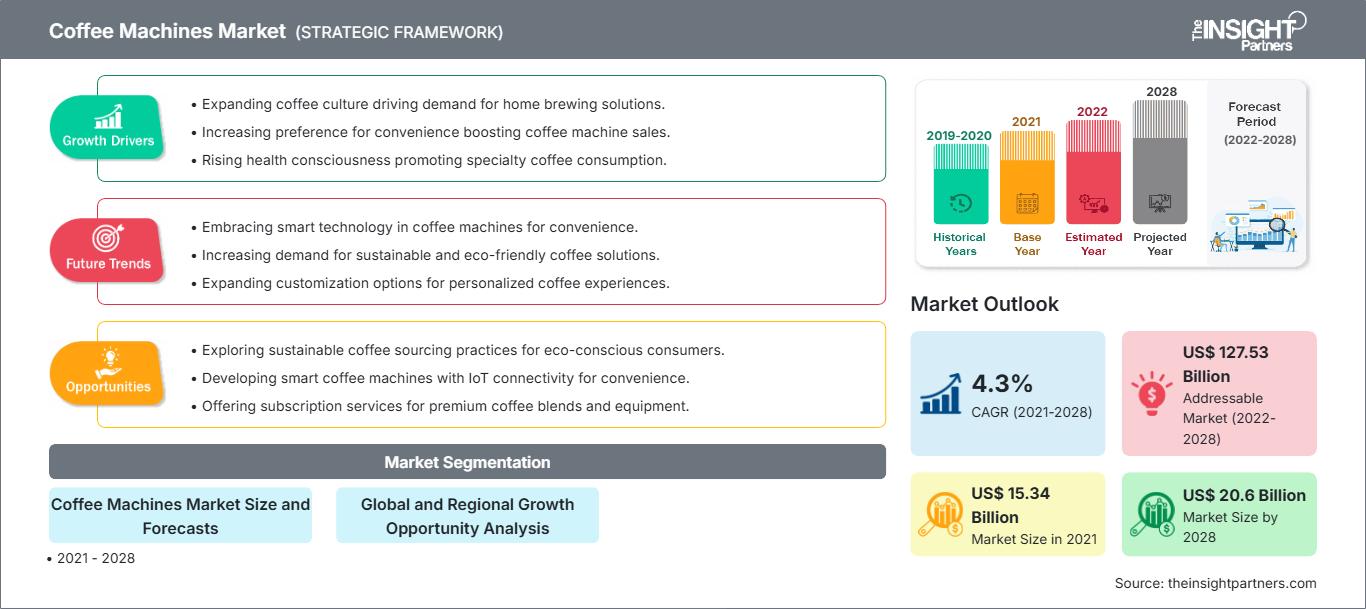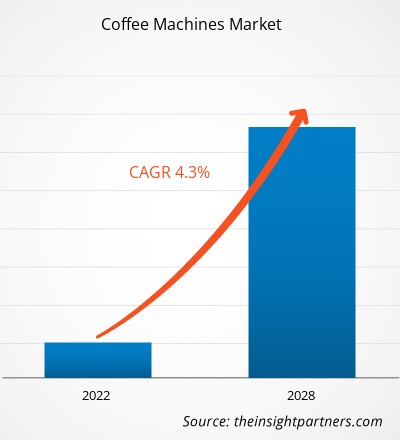[Rapporto di ricerca] Il mercato delle macchine da caffè è stato valutato a 15.340,75 milioni di dollari nel 2021 e si prevede che raggiungerà i 20.596,79 milioni di dollari entro il 2028; si prevede una crescita a un CAGR del 4,3% dal 2021 al 2028.
Approfondimenti di mercato e punto di vista degli analisti:
La macchina da caffè è un dispositivo utilizzato per preparare il caffè. Esistono diversi tipi di macchine da caffè, tra cui la pressa francese, la macchina per caffè espresso, la macchina per caffè filtro, la macchina per caffè a capsule e cialde, tra le altre. Ogni macchina funziona con un meccanismo diverso. Ad esempio, in una macchina da caffè filtro, l'acqua gocciola automaticamente in un tubo riscaldante e viene versata sul caffè macinato che passa attraverso un filtro. Tuttavia, in una macchina da caffè a capsule e cialde, il caffè è confezionato in una capsula di plastica o alluminio e contenuta in un piccolo contenitore che entra nella macchina da caffè, dove il caffè viene preparato. La domanda di macchine da caffè è in crescita sia nel settore aziendale che in quello istituzionale. Questo fattore sta trainando in modo significativo il mercato delle macchine da caffè a livello globale.
Fattori di crescita e sfide:
Negli ultimi anni, lo stile di vita delle persone è cambiato radicalmente a causa di orari di lavoro frenetici e prolungati. A causa dei ritmi frenetici, le persone si stanno orientando sempre più verso cibi e bevande pronti. Nel settore aziendale, le persone sono costantemente esposte allo stress lavorativo, a causa del quale cercano tempo libero da trascorrere con colleghi e amici. Il caffè è una delle bevande versatili più consumate grazie al suo sapore e aroma piacevoli. Inoltre, il suo contenuto di caffeina contribuisce a migliorare l'umore e a indurre la motivazione. Questo fattore sta trainando in modo significativo l'industria del caffè in tutto il mondo. Le macchine da caffè aiutano a preparare il caffè all'istante, motivo per cui c'è una forte domanda di macchine da caffè nel settore aziendale. Questo fattore sta trainando in modo significativo il mercato delle macchine da caffè. Tuttavia, poiché la consapevolezza della forte dipendenza che il caffè crea è in aumento tra le persone, queste stanno sostituendo il caffè con altre bevande come succhi di frutta naturali, bubble tea, acque frizzanti, ecc. Inoltre, la crescente consapevolezza delle implicazioni negative per la salute derivanti da un elevato consumo di caffeina sta ostacolando la domanda di caffè tra gli individui. Si prevede che questi fattori avranno un impatto negativo sul consumo di caffè, frenando la domanda di macchine da caffè nel periodo di previsione.
Personalizza questo rapporto in base alle tue esigenze
Potrai personalizzare gratuitamente qualsiasi rapporto, comprese parti di questo rapporto, o analisi a livello di paese, pacchetto dati Excel, oltre a usufruire di grandi offerte e sconti per start-up e università
Mercato delle macchine da caffè: Approfondimenti strategici

- Ottieni le principali tendenze chiave del mercato di questo rapporto.Questo campione GRATUITO includerà l'analisi dei dati, che vanno dalle tendenze di mercato alle stime e alle previsioni.
Potrai personalizzare gratuitamente qualsiasi rapporto, comprese parti di questo rapporto, o analisi a livello di paese, pacchetto dati Excel, oltre a usufruire di grandi offerte e sconti per start-up e università
Mercato delle macchine da caffè: Approfondimenti strategici

- Ottieni le principali tendenze chiave del mercato di questo rapporto.Questo campione GRATUITO includerà l'analisi dei dati, che vanno dalle tendenze di mercato alle stime e alle previsioni.
Segmentazione e ambito del report
Il "mercato globale delle macchine da caffè" è segmentato in base a tipologia, categoria, utente finale e area geografica. In base alla tipologia, il mercato delle macchine da caffè è segmentato in macchine da caffè filtro, macchine da caffè espresso, macchine da caffè a capsule e cialde e altre. In base alla categoria, il mercato è classificato in manuale, automatico e semiautomatico. In base all'utente finale, il mercato delle macchine da caffè è segmentato in residenziale e non residenziale. Il mercato delle macchine da caffè in base all'area geografica è segmentato in Nord America (Stati Uniti, Canada e Messico), Europa (Germania, Francia, Italia, Regno Unito, Russia e resto d'Europa), Asia Pacifico (Australia, Cina, Giappone, India, Corea del Sud e resto dell'Asia Pacifico), Medio Oriente e Africa (Sudafrica, Arabia Saudita, Emirati Arabi Uniti e resto del Medio Oriente e Africa) e Sud e Africa. America Centrale (Brasile, Argentina e resto dell'America Meridionale e Centrale)
Analisi Segmentale:
In base all'utente finale, il mercato delle macchine da caffè è suddiviso in residenziale e commerciale. Il segmento residenziale detiene una quota significativa nel mercato delle macchine da caffè e si prevede che registrerà una crescita significativa nel periodo di previsione. La crescente adozione del caffè e il crescente interesse per diversi tipi di torrefazione e preparazione stanno trainando la domanda di macchine da caffè nel settore residenziale. Inoltre, a causa dell'epidemia di COVID-19, le persone sono state costrette a rimanere a casa e tutti i punti vendita di ristorazione sono rimasti chiusi. Ciò ha innescato la domanda di macchine da caffè in tutte le famiglie, soprattutto nei paesi sviluppati. Tutti questi fattori stanno potenzialmente stimolando il mercato delle macchine da caffè in tutto il mondo.
Analisi Regionale:
In base all'area geografica, il mercato delle macchine da caffè è suddiviso in cinque regioni chiave: Nord America, Europa, Asia-Pacifico, America Meridionale e Centrale e Medio Oriente e Africa. Il mercato globale delle macchine da caffè è stato dominato dall'Europa, che ha rappresentato 4.951,77 milioni di dollari nel 2022. Il Nord America è il secondo principale contributore, con una quota di mercato globale superiore al 20%. Si prevede che l'area Asia-Pacifico registrerà una crescita considerevole, con un CAGR superiore al 5% nel periodo di previsione. L'aumento del consumo giornaliero di caffè nei paesi nordamericani, in particolare negli Stati Uniti, sta trainando la domanda di macchine da caffè. Secondo la National Coffee Association (NCA), il 62% degli americani consuma caffè quotidianamente. Inoltre, la crescente tendenza al consumo in movimento dovuta allo stile di vita frenetico sta anche guidando la domanda di macchine da caffè nel settore non residenziale in Nord America.
Sviluppi del settore e opportunità future
Di seguito sono elencate varie iniziative intraprese dai principali attori che operano nel mercato delle macchine da caffè:
- A marzo 2023, De'Longhi, uno dei principali produttori di macchine da caffè, ha lanciato Truerew, una macchina da caffè a filtro completamente automatica che elimina la misurazione del caffè e qualsiasi incertezza, consentendo ai consumatori di gustare un caffè macinato fresco di qualità superiore.
- A ottobre 2020, Nespresso Professional ha lanciato nuove funzionalità touchless nelle sue macchine da caffè Nespresso Momento che garantiranno una maggiore sicurezza sui luoghi di lavoro a seguito della pandemia di COVID-19.
- A marzo 2022, Breville Group, produttore australiano di attrezzature per il caffè domestico, ha annunciato l'acquisizione di Lelit, un'azienda italiana di attrezzature per caffè espresso prosumer. Il portfolio di macchine per caffè espresso per uso domestico di Lelit si integra con l'attuale portfolio di attrezzature per caffè per uso domestico del Gruppo Breville. L'acquisizione consentirà all'azienda di soddisfare un ampio pubblico, ampliando la propria portata di consumatori e incrementando i ricavi.
- A marzo 2021, De'Longhi ha acquisito il restante 60% delle azioni di Eversys, un produttore svizzero di macchine da caffè. L'azienda vanta un portfolio di macchine per caffè espresso completamente automatiche. L'acquisizione consentirà a De'Longhi di espandere la propria linea di prodotti e di soddisfare un ampio numero di consumatori in diverse regioni.
Impatto del COVID-19:
La pandemia di COVID-19 ha colpito quasi tutti i settori in diversi paesi. Lockdown, restrizioni di viaggio e chiusure aziendali in Nord America, Europa, Asia-Pacifico (APAC), Sud e Centro America (SAM) e Medio Oriente e Africa (MEA) hanno ostacolato la crescita di diversi settori, tra cui quello dei beni di consumo. La chiusura delle unità produttive ha interrotto le catene di approvvigionamento globali, le attività produttive, i programmi di consegna e le vendite di prodotti essenziali e non essenziali. Diverse aziende hanno registrato ritardi nelle consegne e un crollo delle vendite nel 2020. A causa della recessione economica causata dalla pandemia, i consumatori sono diventati più cauti e selettivi nelle loro decisioni di acquisto. Gli acquisti non essenziali sono stati significativamente ridotti dai consumatori a causa dei redditi più bassi e delle incerte prospettive di guadagno, soprattutto nelle regioni in via di sviluppo. Molti produttori di macchine da caffè hanno dovuto affrontare un calo dei profitti a causa della riduzione della domanda dei consumatori durante la fase iniziale della pandemia. Tuttavia, entro la fine del 2021, molti paesi erano completamente vaccinati e i governi hanno annunciato un allentamento di alcune normative, tra cui lockdown e divieti di viaggio. Le persone hanno iniziato a viaggiare in luoghi diversi, il che ha aumentato la domanda di caffè negli aeroporti e nelle stazioni ferroviarie, incrementando la domanda di macchine da caffè. Tutti questi fattori hanno avuto un impatto positivo sulla crescita del mercato delle macchine da caffè in diverse regioni.
Approfondimenti regionali sul mercato delle macchine da caffè
Le tendenze regionali e i fattori che influenzano il mercato delle macchine da caffè durante il periodo di previsione sono stati ampiamente spiegati dagli analisti di The Insight Partners. Questa sezione analizza anche i segmenti e la distribuzione geografica del mercato delle macchine da caffè in Nord America, Europa, Asia-Pacifico, Medio Oriente e Africa, America Meridionale e Centrale.
Ambito del rapporto di mercato sulle macchine da caffè
| Attributo del rapporto | Dettagli |
|---|---|
| Dimensioni del mercato in 2021 | US$ 15.34 Billion |
| Dimensioni del mercato per 2028 | US$ 20.6 Billion |
| CAGR globale (2021 - 2028) | 4.3% |
| Dati storici | 2019-2020 |
| Periodo di previsione | 2022-2028 |
| Segmenti coperti |
By Dimensioni e previsioni del mercato delle macchine da caffè
|
| Regioni e paesi coperti | Nord America
|
| Leader di mercato e profili aziendali chiave |
|
Densità degli operatori del mercato delle macchine da caffè: comprendere il suo impatto sulle dinamiche aziendali
Il mercato delle macchine da caffè è in rapida crescita, trainato dalla crescente domanda degli utenti finali, dovuta a fattori quali l'evoluzione delle preferenze dei consumatori, i progressi tecnologici e una maggiore consapevolezza dei vantaggi del prodotto. Con l'aumento della domanda, le aziende stanno ampliando la propria offerta, innovando per soddisfare le esigenze dei consumatori e sfruttando le tendenze emergenti, alimentando ulteriormente la crescita del mercato.

- Ottieni il Mercato delle macchine da caffè Panoramica dei principali attori chiave
Panorama competitivo e aziende chiave:
Alcuni dei principali attori che operano nel mercato globale delle macchine da caffè includono, tra gli altri, Keurig Green Mountain, Inc.; Robert Bosch GmbH; Electrolux AB; illycaffè SpA; Koninklijke Philips NV; Krups GmBH (Groupe SEB); Morphy Richards; Nestlé SA; Panasonic Corporation; LUIGI LAVAZZA SPA; De'Longhi Appliances Srl. Questi attori offrono macchine da caffè all'avanguardia con caratteristiche e tecniche di erogazione innovative per offrire ai consumatori un'esperienza di caffè superiore.
- Analisi storica (2 anni), anno base, previsione (7 anni) con CAGR
- Analisi PEST e SWOT
- Valore/volume delle dimensioni del mercato - Globale, Regionale, Nazionale
- Industria e panorama competitivo
- Set di dati Excel
Report recenti
Rapporti correlati
Testimonianze
Motivo dell'acquisto
- Processo decisionale informato
- Comprensione delle dinamiche di mercato
- Analisi competitiva
- Analisi dei clienti
- Previsioni di mercato
- Mitigazione del rischio
- Pianificazione strategica
- Giustificazione degli investimenti
- Identificazione dei mercati emergenti
- Miglioramento delle strategie di marketing
- Aumento dell'efficienza operativa
- Allineamento alle tendenze normative




















 Ottieni un campione gratuito per - Mercato delle macchine da caffè
Ottieni un campione gratuito per - Mercato delle macchine da caffè